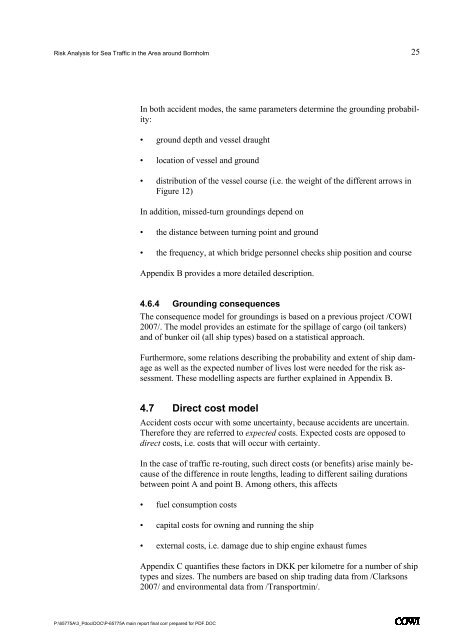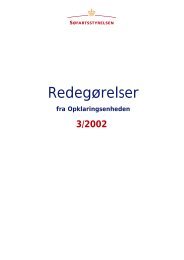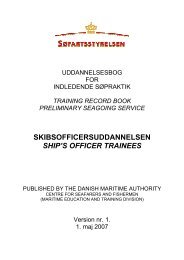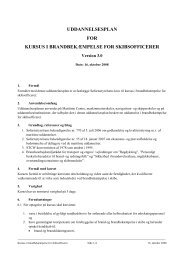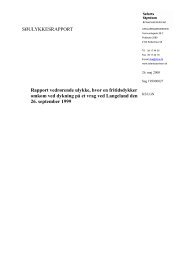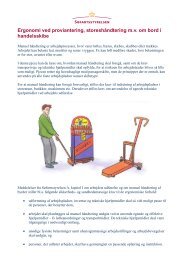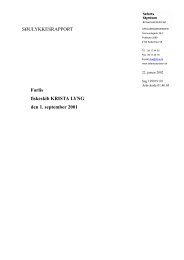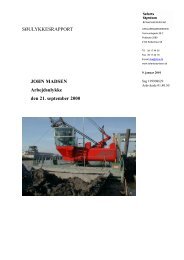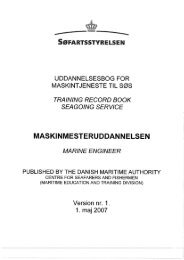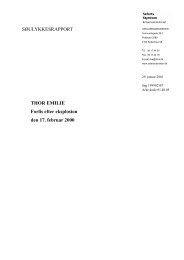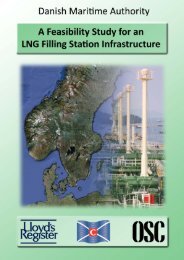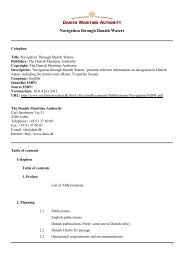Risk Analysis of Sea Traffic in the Area around Bornholm, 2008. - VTT
Risk Analysis of Sea Traffic in the Area around Bornholm, 2008. - VTT
Risk Analysis of Sea Traffic in the Area around Bornholm, 2008. - VTT
- No tags were found...
You also want an ePaper? Increase the reach of your titles
YUMPU automatically turns print PDFs into web optimized ePapers that Google loves.
<strong>Risk</strong> <strong>Analysis</strong> for <strong>Sea</strong> <strong>Traffic</strong> <strong>in</strong> <strong>the</strong> <strong>Area</strong> <strong>around</strong> <strong>Bornholm</strong><br />
25<br />
In both accident modes, <strong>the</strong> same parameters determ<strong>in</strong>e <strong>the</strong> ground<strong>in</strong>g probability:<br />
• ground depth and vessel draught<br />
• location <strong>of</strong> vessel and ground<br />
• distribution <strong>of</strong> <strong>the</strong> vessel course (i.e. <strong>the</strong> weight <strong>of</strong> <strong>the</strong> different arrows <strong>in</strong><br />
Figure 12)<br />
In addition, missed-turn ground<strong>in</strong>gs depend on<br />
• <strong>the</strong> distance between turn<strong>in</strong>g po<strong>in</strong>t and ground<br />
• <strong>the</strong> frequency, at which bridge personnel checks ship position and course<br />
Appendix B provides a more detailed description.<br />
4.6.4 Ground<strong>in</strong>g consequences<br />
The consequence model for ground<strong>in</strong>gs is based on a previous project /COWI<br />
2007/. The model provides an estimate for <strong>the</strong> spillage <strong>of</strong> cargo (oil tankers)<br />
and <strong>of</strong> bunker oil (all ship types) based on a statistical approach.<br />
Fur<strong>the</strong>rmore, some relations describ<strong>in</strong>g <strong>the</strong> probability and extent <strong>of</strong> ship damage<br />
as well as <strong>the</strong> expected number <strong>of</strong> lives lost were needed for <strong>the</strong> risk assessment.<br />
These modell<strong>in</strong>g aspects are fur<strong>the</strong>r expla<strong>in</strong>ed <strong>in</strong> Appendix B.<br />
4.7 Direct cost model<br />
Accident costs occur with some uncerta<strong>in</strong>ty, because accidents are uncerta<strong>in</strong>.<br />
Therefore <strong>the</strong>y are referred to expected costs. Expected costs are opposed to<br />
direct costs, i.e. costs that will occur with certa<strong>in</strong>ty.<br />
In <strong>the</strong> case <strong>of</strong> traffic re-rout<strong>in</strong>g, such direct costs (or benefits) arise ma<strong>in</strong>ly because<br />
<strong>of</strong> <strong>the</strong> difference <strong>in</strong> route lengths, lead<strong>in</strong>g to different sail<strong>in</strong>g durations<br />
between po<strong>in</strong>t A and po<strong>in</strong>t B. Among o<strong>the</strong>rs, this affects<br />
• fuel consumption costs<br />
• capital costs for own<strong>in</strong>g and runn<strong>in</strong>g <strong>the</strong> ship<br />
• external costs, i.e. damage due to ship eng<strong>in</strong>e exhaust fumes<br />
Appendix C quantifies <strong>the</strong>se factors <strong>in</strong> DKK per kilometre for a number <strong>of</strong> ship<br />
types and sizes. The numbers are based on ship trad<strong>in</strong>g data from /Clarksons<br />
2007/ and environmental data from /Transportm<strong>in</strong>/.<br />
P:\65775A\3_Pdoc\DOC\P-65775A ma<strong>in</strong> report f<strong>in</strong>al corr prepared for PDF.DOC<br />
.


